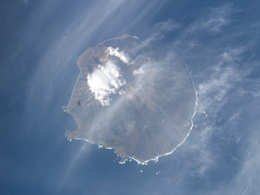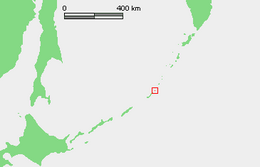Ketoy
Native name: Кетой | |
|---|---|
 NASA picture of Ketoy Island | |
 | |
| Geography | |
| Location | Sea of Okhotsk |
| Coordinates | 47°21′00″N 152°28′30″E / 47.35°N 152.475°E |
| Archipelago | Kuril Islands |
| Area | 73 km2 (28 sq mi) |
| Highest elevation | 1,172 m (3845 ft) |
| Highest point | Ketoy |
| Administration | |
Russia | |
| Demographics | |
| Population | 0 |
| Ethnic groups | Ainu (formerly) |
Ketoy (or Ketoi) (Russian: Кетой; Japanese

Geography
[edit]The shape of the island is almost circular: approximately 10 km in length by approximately 9 km in width, with an area of 71.25 square kilometres (27.51 sq mi) [1] The length of the coastline is 38.3 kilometers. Despite its relatively small area, the island has much landscape diversity, which is explained by its complex geomorphology, in which there are stratovolcanic cones, calderas, lava flows, volcanic plateaus, various valleys, high and steep coastal ledges, sea terraces, and rocky beaches. The steep cliffs ranging from 30 metres to 60 metres on the east and south sides with the west and north being taller. The beaches on the island consist of boulders and stones. The rivers and streams are numerous: mostly flowing to the south and east. The terrain is undulating and steep with numerous hills, rising to two main peaks:
The highest point is Mount Ketoy -(Russian: влк Кетой; Japanese
The second peak is Pallas -(Russian: влк Палласа; Japanese
History
[edit]Ketoy had no permanent habitation prior to European contact, but was visited in summer by the Ainu tribes from Rasshua for hunting. Members of the Russian expedition who visited the island in 1811, found the remains of a wooden cross with the word "God", which was presented as evidence of the gradual Christianization and Russification of the Ainu; however, a census in 1831 found no permanent inhabitants. Claimed by the Empire of Russia, sovereignty was passed to the Empire of Japan per the Treaty of Saint Petersburg along with the rest of the Kuril islands. The island was formerly administered as part of Shimushiro District of Nemuro Subprefecture of Hokkaidō. After World War II, the island came under the control of the Soviet Union, and is now administered as part of the Sakhalin Oblast of the Russian Federation.
See also
[edit]References
[edit]- ^ "International Kuril Island Project(IKIP)". University of Washington Fish Collection or the respective authors. Archived from the original on 2012-10-06. Retrieved 2009-12-03.
- ^ "Ketoi". Global Volcanism Program. Smithsonian Institution. Retrieved 2021-06-25.
- ^ "Ketoi: Eruptive History". Global Volcanism Program. Smithsonian Institution. Retrieved 2021-06-25.
Further reading
[edit]- Gorshkov, G. S. Volcanism and the Upper Mantle Investigations in the Kurile Island Arc. Monographs in geoscience. New York: Plenum Press, 1970. ISBN 0-306-30407-4
- Krasheninnikov, Stepan Petrovich, and James Greive. The History of Kamtschatka and the Kurilski Islands, with the Countries Adjacent. Chicago: Quadrangle Books, 1963.
- Rees, David. The Soviet Seizure of the Kuriles. New York: Praeger, 1985. ISBN 0-03-002552-4
- Takahashi, Hideki, and Masahiro Ōhara. Biodiversity and Biogeography of the Kuril Islands and Sakhalin. Bulletin of the Hokkaido University Museum, no. 2-. Sapporo, Japan: Hokkaido University Museum, 2004.
External links
[edit]- Active volcanoes
- Islands of the Sea of Okhotsk
- Islands of the Russian Far East
- Stratovolcanoes of Russia
- Islands of the Kuril Islands
- Uninhabited islands of Russia
- Uninhabited islands of the Pacific Ocean
- Calderas of Russia
- Volcanoes of the Kuril Islands
- Mountains of the Kuril Islands
- Holocene stratovolcanoes
